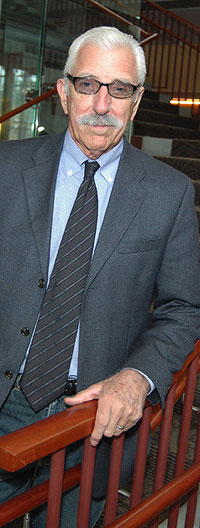
| A
Dean's Vision Becomes Reality |
||
BY GAIL MATSUNAGA What a journey it's been for Jerry Samuelson, dean of the College of the Arts. For the past 20 years, he has been the standard bearer of the dream of a new Performing Arts Center -- overseeing the project's various incarnations, the ups and downs of bond issues, and campaigning for funds and political support. As the final elements are being set in place, Samuelson recounted some of the efforts to bring the center to fruition and what it means for future generations of performing arts students. Q: How does it feel to be this close to completion? A: Actually, this is nervous time. There are a few things that are not quite finished. The canopy over the concert hall stage has to be in place before all the acoustics elements in the concert hall are complete. This month, we need to bring each performance group -- orchestra, choral, jazz, wind ensemble -- into the hall and adjust the acoustic environment for each. Q: Overall, how did the project come about? A: We started thinking about a new performing arts building 20 years ago. Our first concept was a 1,200-seat auditorium/multipurpose facility that could be used for all theater, dance and music performances. This was based on a [California State University Board of Trustees] policy that recommends a 1,200-seat facility on all large campuses. Multipurpose centers have been built at Long Beach, Los Angeles and San Luis Obispo in recent years. Our first plans were drawn up, but the cost estimate was considered excessive. To save the project, Jay Bond [associate vice president for facilities management] and I went to the CSU Chancellor's Office with a proposal to break the large facility into smaller performance venues, which would not only save money, but better serve our specialized instructional needs. Students need the opportunity to perform in front of audiences -- it's a very important part of the process for all disciplines, and the venue for a music performance is very different than for theater and dance. We now have four new discipline-specific performance spaces. Adding in our existing 500-seat theater and recital hall, we can have six performances going on at once. In the last several national accreditation visits, the only part of our programs that did not meet standards was adequate space and time for performances. Each time we promised them that the new building was going to solve this and we would meet the accreditation standards soon. Soon has finally arrived. It isn't just performance spaces. We now have three new spacious dance studios so that dancers don't touch the ceiling as they do their jumps and lifts. We have a wonderful new studio for our musical theater program and a wonderful, new shop that will service all the theater facilities. Q: Why did it take so long? A: Instructional construction projects rely mainly on state bond funding and where a project is on a long list of building needs in the CSU system. The first bond issue passed but we were not high enough on the system list to be funded. A second bond issue passed in 2001, and President Milton A. Gordon was very instrumental in convincing the chancellor's staff that our project should be funded. Although it was in the governor's proposed budget for 2001-02, the drama was not over. The senate budget committee recommended approval, but the assembly budget committee recommended no funding. Fortunately, the joint budget committee came to a positive recommendation and with the governor's signature, we had the funds to start the building in 2003. During this critical time we took students to Sacramento to meet with key legislators to plead our cause. The students were enthusiastic, young and wonderful. Some of our representatives were receptive and listened to us, and some weren't so sympathetic to our cause. It was a real life educational experience for our students. State funds were not quite enough to cover the cost of the construction, so we've been on a fund-raising campaign, and at this point, we've raised about $2.5 million to help complete the building. The community response has been wonderful with over 100 donors making contributions. Q: What are some of the features or technologies in this building that may not have existed, or weren't attainable before? A: In round terms, there is a little over $1 million in new lighting equipment and a little over $1 million in sound equipment -- equipment that belongs to this century. There's new equipment in the costume shop, scene shop, computer lab and makeup lab studio, giving us back-of-the-house support that we really needed for our programs. Q: Where do you see the performing arts program going? A: We will have excellent facilities to match our excellent programs. Expanding into this new center is our opportunity to give our talented students and instructors the environment for excellence and to bring more people from the community onto campus to enjoy the results of their creative endeavors. Q: What's next for you? A: I really haven't focused on that -- I've been so focused on the building and getting it open, and planning for the opening. And then planning the spring season ... so to be honest, I haven't really thought about it.
|



|
|
| Produced by the Office of
Public Affairs at California State University, Fullerton. Contact the web administrator for comments and problems with the website. California State University, Fullerton © 2005. All Rights Reserved. |
